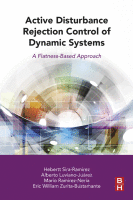Browse content
Table of contents
Actions for selected chapters
- Full text access
- Book chapterAbstract only
Chapter 1 - Introduction
Pages 1-11 - Book chapterAbstract only
Chapter 2 - Generalities of ADRC
Pages 13-50 - Book chapterAbstract only
Chapter 3 - Merging Flatness, GPI Observation, and GPI Control with ADRC
Pages 51-107 - Book chapterAbstract only
Chapter 4 - Extensions of ADRC
Pages 109-172 - Book chapterAbstract only
Chapter 5 - Case Studies
Pages 173-234 - Book chapterAbstract only
Chapter 6 - The Challenging Case of Underactuated Systems
Pages 235-284 - Book chapterNo access
Appendix A - Differential Flatness
Pages 285-297 - Book chapterNo access
Appendix B - Generalized Proportional Integral Control
Pages 299-337 - Book chapterNo access
Index
Pages 339-340
About the book
Description
Active Disturbance Rejection Control of Dynamic Systems: A Flatness Based Approach describes the linear control of uncertain nonlinear systems. The net result is a practical controller design that is simple and surprisingly robust, one that also guarantees convergence to small neighborhoods of desired equilibria or tracking errors that are as close to zero as desired.
This methodology differs from current robust feedback controllers characterized by either complex matrix manipulations, complex parameter adaptation schemes and, in other cases, induced high frequency noises through the classical chattering phenomenon.
The approach contains many of the cornerstones, or philosophical features, of Model Free Control and ADRC, while exploiting flatness and GPI control in an efficient manner for linear, nonlinear, mono-variable and multivariable systems, including those exhibiting inputs delays.
The book contains successful experimental laboratory case studies of diverse engineering problems, especially those relating to mechanical, electro-mechanical, robotics, mobile robotics and power electronics systems.
Active Disturbance Rejection Control of Dynamic Systems: A Flatness Based Approach describes the linear control of uncertain nonlinear systems. The net result is a practical controller design that is simple and surprisingly robust, one that also guarantees convergence to small neighborhoods of desired equilibria or tracking errors that are as close to zero as desired.
This methodology differs from current robust feedback controllers characterized by either complex matrix manipulations, complex parameter adaptation schemes and, in other cases, induced high frequency noises through the classical chattering phenomenon.
The approach contains many of the cornerstones, or philosophical features, of Model Free Control and ADRC, while exploiting flatness and GPI control in an efficient manner for linear, nonlinear, mono-variable and multivariable systems, including those exhibiting inputs delays.
The book contains successful experimental laboratory case studies of diverse engineering problems, especially those relating to mechanical, electro-mechanical, robotics, mobile robotics and power electronics systems.
Key Features
- Provides an alternative way to solve disturbance rejection problems and robust control problem beyond the existing approaches based on matrix algebra and state observers
- Generalizes the widely studied Extended State Observer to a class of observers called Generalized Proportional Integral Observers (GPI Observers)
- Contains successful experimental laboratory case studies
- Provides an alternative way to solve disturbance rejection problems and robust control problem beyond the existing approaches based on matrix algebra and state observers
- Generalizes the widely studied Extended State Observer to a class of observers called Generalized Proportional Integral Observers (GPI Observers)
- Contains successful experimental laboratory case studies
Details
ISBN
978-0-12-849868-2
Language
English
Published
2017
Copyright
Copyright © 2017 Elsevier Inc. All rights reserved.
Imprint
Butterworth-Heinemann
